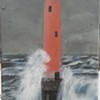North Carolina lit lovers can take a rather action-packed literary road trip with a little advance planning and a minimum of cash (even if one doesn't have the carte blanche of writing for a swanky weekly newspaper). Indeed, it's perhaps more fun to do it on a shoestring, imagining yourself setting off on a journey that one of our Carolina-centric authors might have made: in a car, fortified with fried chicken and cold cuts, a good book, a good friend, and little else. Imagine it: barreling across our great state, soaking up the land and the people, and then turning it into crystalline prose.
Well, one can hope, right?
One relatively easy arc for the prospective literary traveler is the Charlotte to Asheville jaunt. Within the space of a couple of hours (and if there were a way to subtract Shelby from the equation, an hour-and-a-half), one may walk the same ground as Thomas Wolfe, Carl Sandburg, F. Scott Fitzgerald, and O. Henry. For those who get into such things, you can even see the ground Henry and Wolfe are now buried in.
Leaving Charlotte, take I-85 to Highway 74, so you can drive through the birthplace of Earl Scruggs -- Shelby, NC -- and eat at Bridges Barbecue, an unquestioned state cultural and culinary treasure.
Keep driving, and about 45 minutes (and a little heartburn) later, you should see exit signs for historic Flat Rock, NC.
Twenty-four miles south of Asheville (and about five miles off the freeway) stands a 22-room white mansion, nested on an estate of 245 rolling acres of pristine farmland. The homestead is called Connemara, and it was the longtime home of Carl Sandburg, America's Poet of the People and famed Lincoln biographer. Sold to the government after his death, Connemara is maintained as a National Historic Site by the US Park Service. The house itself, tiny from the road but gargantuan up close, sits at the absolute top of a large hill, and the driveway is roughly a quarter of a mile long. If one falls into the elderly, handicapped, or "just plain lazy" category, there are handy white courtesy phones and restrooms, lest you don't think you can wait.
Sandburg moved to the hills of North Carolina in 1945 at the age of 67 with his goat-crazy wife Lillian, his three daughters and his two grandchildren. Mr. Sandburg loved the mountain air and intense privacy, and Lillian liked the acreage, crucial as it was to continue her obsession with raising goats (by the 1950s, she had over 200 and had a good little business selling goat products by mail order). Indeed, some of the goats that remain at Connemara are related to the original goats. No word if they've been officially deemed historic.
The house has remained fundamentally unchanged from the days when the Sandburgs lived in it. Books and magazines are strewn about, and many still have Sandburg's address affixed to them. However, many of the bookshelves are now covered by Plexiglas, the better to keep away well-read scalawags who are looking for a souvenir. Damn it.
Just around the corner in quaint old Hendersonville, you can find "Wolfe's Angel," you can find "Wolfe's Angel." The statue, one of 15 or so sold by Wolfe's father W.O. at his Asheville shop, bears the closest resemblance to the one described in Thomas Wolfe's landmark Look Homeward, Angel, and now stands in Oakdale Cemetery. A handy road sign alerts passersby to the tranquil boneyard, where the weathered angel still maintains much of its disturbing, cab-hailing beauty.
Speaking of Thomas Wolfe (and cemeteries), the man himself is buried close by, in Asheville's Riverside cemetery, near downtown. His burial plot is a simple one, with a small headstone reading "Tom" (Those who read the "other" Wolfe's Man In Full can only dream...), along with quotes from a few of his books. Traveling in the Pacific Northwest, Wolfe told his hapless doctors that he became sick while sharing a drink of whiskey with a shivering man on a ferry (always a bad idea, to my way of thinking). The sickness soon became pneumonia, which led to TB, which led to a coma, which led Wolfe to look homeward one last time: "Tom" died September 15, 1938, just short of his 38th birthday.
Buried in the same cemetery (just a few paces away) is William Sidney Porter, otherwise known as O. Henry, one of the most popular short story writers of the early 20th century. The candy bar magnate (OK, so I'm making that up) was born near Greensboro in 1862. After a period tramping around North Carolina, Texas, and Honduras, Porter returned to the states to visit his ailing wife Sarah Coleman (also stricken with the dread scourge TB), whereupon he was arrested for embezzlement. In jail, he began writing stories under the name of O. Henry, to modest acclaim. Upon his release, he went to New York, and soon became one of the best-selling writers of his generation. After his death in 1910, he was buried in Asheville, near the Weaverville home of his wife.
For the Wolfe completists among our readers, The Thomas Wolfe Memorial in downtown Asheville consists mainly of his mother's large boardinghouse, where Wolfe spent many of his formative years. Originally christened "Old Kentucky Home" by a previous owner with no sense of geography, Wolfe famously re-imagined the structure as "Dixieland" in Look Homeward, Angel.
Born October 3, 1900, at 92 Woodfin Street, Wolfe, likely the most autobiographical novelist of his era, recast this mountain city as his own, to sometimes brutal backlash from the citizenry. As often happens in these situations, the town now loves him to death, as most of the people he originally (and rightfully) skewered have long since passed. Much of the original house was destroyed in a 1998 arson fire, and repairs are ongoing. However, a visitor center is on site, and has much information for folks interested in Asheville's favorite son.
Less accessible, but infinitely more fun, are the F. Scott Fitzgerald rooms at the stately Grove Park Inn, which overlooks downtown. F. Scott stayed here in the summer of 1936 while wife Zelda recuperated in Asheville's Highland Hospital. The Grove Park, one of the most famous inns in the Southeast, is worth a visit in its own right for those interested in history. Since its inception in 1913, the Inn has hosted golfing legend Bobby Jones, Margaret Mitchell, Dwight D. Eisenhower, Will Rogers, Bush The Senior, Richard Nixon, William Howard Taft, Calvin Coolidge, Herbert Hoover, Woodrow Wilson, Henry Ford, Thomas Edison, Bela Bartok, Harry Houdini, Helen Keller, Enrico Caruso, and about a million other folks, many more famous and most much wealthier than yours truly (including, I kid you not, the New Yankee Workshop's Norm Abrams, who for some reason has a room named after him).
None of which, mind you, stopped me from renting Fitzgerald's Room 441, or stopped me from being disappointed that there wasn't an F. Scott Minibar, as I had expected. The room was resplendent with original Arts and Crafts furniture, including what is thought to be Fitzgerald's desk (where, incidentally, a portion of this article was written -- woo-hoo!). On the wall behind the double beds (Why did Fitzgerald need double beds? We'll come back to that...) are pictures of Scott and Zelda, and also a framed article written by novelist Allan Gurganus about staying in the room trying to channel Fitzgerald. (I, in turn, must now channel Gurganus, I suppose. Pity the person that follows me.)
The Fitzgerald suite (rooms 441 and 443) overlooks the entrance to the Inn. Popular opinion holds that while doting on his wife, Scott also doted on rich young dames arriving alone by car, all of whom he spied from his window perch (I tried it, and got the damn gardener).
Although I was never able to find it, there is supposedly a bullet hole in the ceiling from one of Scott's drunken rages. According to Grove Park legend, maids would come each morning and remove liquor bottles from Fitzy's trash. Never one to avoid a challenge and fond of living vicariously through my literary idols, I searched the cavernous Grove Park for a soda machine -- which, if you're ever interested, is beside the Henry Kissinger room -- to find a suitable mixing ingredient for some bourbon I had stowed in my luggage. But hell -- I couldn't stay in my room all night. Certainly F. Scott wouldn't have. He'd have been soaking up life, soaking up alcohol, and soaking the sheets with debutante sweat. F. Scott Fitzgerald, however, didn't go on tightly scheduled (and budgeted) road trips to see the literary sights of Western North Carolina. He was a literary sight in Western North Carolina.
The surrounding mountains and all their iridescent lures would have to wait, I decided. I put the pen and pad back in the room, headed to the lobby bar, ordered a round, and toasted Scott, Tom, Carl, O, and all the other lights shining up here in the obsidian-black night of the Appalachians. After all, I had a date for the evening: a Grand Old Dame with a 50-foot fireplace for a heart, who, even after all her flings with the rich and famous, looked liked she still needed company.
Speaking of News_.html, 2.00000
-
Letters To The Editor
Nov 28, 2007 -

Zoom-Zoom
Nov 14, 2007 -

October's Fests
Oct 3, 2007 - More »
Latest in Cover
More by Timothy C. Davis
-

Smoke This Issue: Eats
Apr 18, 2012 -
Joe Firstman tonight (Nov. 10) at The Evening Muse
Nov 10, 2010 -
Hot Rize tonight (Nov. 5) at McGlohon Theatre
Nov 5, 2010 - More »
Calendar
-

Queen Charlotte Fair @ Route 29 Pavilion
-

NEW WINDOW GALLERY-Pat Rhea-ACRYLIC PAINTINGS-April 05-30 2024 VALDESE, NC 28690 @ New Window Gallery/Play It Again Records
- Through April 30, 12 p.m.
-

TheDiscountCodes
-

Wine & Paint @ Blackfinn Ameripub- Ballantyne
-

Face to Face Foundation Gala @ The Revelry North End
-
Five Common Reasons Why Small Businesses Fail
-
Homer's night on the town 41
If you drank a shot with the Knights mascot on Sept. 20, you were basically harboring a fugitive
-
6 Factors to Consider When Buying Kratom Online 5










